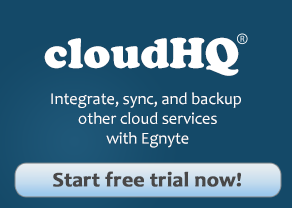Cloud Power: How to Integrate Egnyte with other Cloud Services
Cloud-based tools like Egnyte continue to transform the way we work. And as more tools and services are created, it’s become clear that the key to unlocking the true power of the cloud is to assemble a customized toolkit that not only complements your workflow, but also improves and enhances it.As I keep a close eye on the evolution of cloud platforms, one of the more popular combinations that’s emerged is Egnyte synced with Basecamp, Evernote, and Microsoft’s SharePoint, thanks in large part to Egnyte’s position as a leader for a cloud-based central storage point, especially at the enterprise level.Yet as companies integrate cloud-based services like Basecamp or SharePoint, they often run into a problem of multiple installations. When that happens, a company might have different versions of SharePoint that are located on-premises and are separate from what’s located in the cloud. As a result, the enhanced accessibility and productivity of the cloud is a moot point since most employees can’t be assured they’re accessing the most up-to-date documents they need—and that’s why it’s increasingly important to integrate Egnyte (and Basecamp, Evernote, and SharePoint) with other cloud tools.How Egnyte Helps Eliminate a Pervasive Cloud IssueThat sort of confusion among different versions of documents isn’t the only issue to emerge amid increased cloud adoption. Data gravity is also proving to be more problematic, especially for enterprise-level companies that deal with high volumes of information. As you’ve probably read on the Egnyte blog, data gravity occurs once data has grown exponentially and becomes difficult to move to the cloud because of its sheer magnitude or due to privacy or regulatory concerns.Since Evernote, Basecamp, and SharePoint have a wide range of enterprise functionality, it’s safe to assume that, at some point, users might run into data gravity issues, which aren’t just problematic to individual users—they’re proving to be a hindrance to enterprise IT teams, too.But by adding Egnyte to the mix, enterprise companies can enhance other cloud apps’ capabilities with services like cloud file sharing, private file sharing, local file access and cross-office collaboration, all of which enable seamless access and file sharing from any device. Isn’t that sort of instant (and constant) access what the cloud is all about?

For companies that already use SharePoint, adding Egnyte to the mix is a move that makes sense. Yet to add even more functionality—not to mention the peace of mind that comes from data security—it’s important to complete the cloud platform trifecta with cloudHQ.How cloudHQ Helps a Cloud-Based Enterprise WorkflowcloudHQ continuously synchronizes and replicates data between multiple cloud services in real-time, which means you have access to your information any time you need it—and regardless of how many cloud tools you use.When you add cloudHQ to your cloud toolkit, you know your data is accessible and protected in a secure, centralized location like Egnyte, even if you’re dealing with large amounts of data and information. At cloudHQ, we currently sync more than 10 million files each day, which means we’re no strangers to dealing with a high volume of data.Interested in adding Egnyte and cloudHQ to your existing SharePoint system? Try a free cloudHQ trial paired with Egntye to see how you can make your SharePoint workflow even more robust and efficient. The cloud is as powerful as you make it—and by using this particular suite of tools, you’ll achieve an optimal level of efficiency, productivity, access and collaboration that won’t just impact your employee’s to-do lists—it’ll have a noticeable impact on your company’s bottom line, too.

cloudHQ was founded in 2011 by current CEO Senad Dizdar, who has over 23 years of data infrastructure experience at Oracle. The cloudHQ service uses automatic replication to copy data from one cloud service to another to enable:
- Sharing of files and data across multiple platforms
- Integration between cloud services that do not offer integration
- Create and maintain a centralized database of data from multiple cloud services
- Project collaboration across multiple platforms
- Backup of data to prevent data loss





